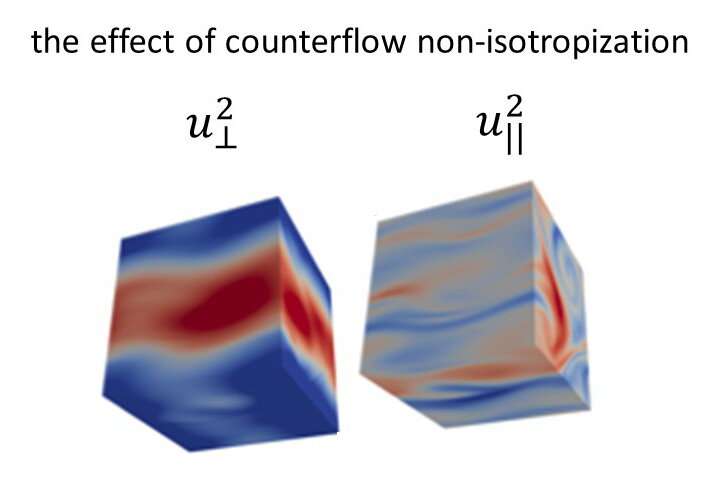April 22, 2019 feature
Study shows the difference between classical flows and superfluid helium in 3-D counter-flow

Researchers at the Weizmann Institute of Science, the University of Rome, CNRS and the University of Helsinki have recently carried out a study investigating the difference between 3-D anisotropic turbulence in classical fluids and that in superfluids, such as helium. Their findings, published in Physical Review Letters (PRL), are supported by both theory and experimental evidence.
"The present research was initiated by our group at the Weizmann Institute, Israel, comprised by Victor L'vov, Itamar Procaccia and Anna Pomyalov, who were trying to understand novel experimental observations by the groups of Prof. Wei Guo from Florida State University, Tallahassee and Prof. Ladislav Skrbek from Charles University, in Prague," Itamar Procaccia, one of the researchers who carried out the study, told Phys.org. "Our main objective was to understand an apparent surprising difference in how energy distributes between turbulent eddies of different scales in classical viscous fluids like air and water and superfluids like helium at low temperatures."
All turbulent flows, both in nature and laboratory settings, are anisotropic on energy injection scales, meaning that energy distributes differently between their turbulent eddies. Past studies have shown that the model of homogeneous and isotropic turbulence (HIT) is particularly effective for predicting the statistical properties of turbulence on scales much smaller than stirring scales, yet larger than dissipative scales.
In classical fluids, 3-D anisotropic turbulence tends towards isotropy and homogeneity with decreasing scales, hence it is eventually possible to apply the HIT model to them. In their study, however, Procaccia and his colleagues demonstrated that the opposite is true for superfluid 4He turbulence in 3-D counter-flow channel geometry, which becomes less isotropic as scales decrease, to the point of becoming almost two-dimensional.
The approach used by them involves a so-called 'two-fluid model' of superfluid helium. This model is based on the early work of Laszlo Tisza and Lev Landau back in 1940-1941, which was later improved by H. Hall, W.F. Vinen, I.M. Khalatnikov, and I.L Bekarevich.
"The model describes superfluid helium as an interpenetrating mixture of two fluids: a superfluid that moves without friction, and a normal viscous fluid that are coupled by a mutual friction," Procaccia explained.
Past studies carried out by two teams of researchers in Tallahasse, Florida and Prague examined superfluid helium under a temperature gradient, creating what is referred to as 'counter-flow'. As suggested by its name, in counter-flow different components of a fluid flow in opposite directions; the superfluid flows from the cold to the hot side and the normal fluid from the hot to the cold side.
"Our model rationalized some of these experimental observations and predicted new features that were later confirmed experimentally," Procaccia explained. "The main result of our study is that contrary to classical turbulent flows which become more and more isotropic at smaller scales, the flow we examined becomes less and less isotropic as the scales reduce."
Before they carried out their study, Procaccia and his colleagues had theoretically predicted that their experiments would lead to the observations that they subsequently collected. However, the strength of the effect they observed only became clear after they carried out direct numerical simulations on a EU supercomputer, in collaboration with a team of researchers led by Luca Biferale. According to Procaccia, their theoretical and numerical findings have already motivated other experimental groups to pursue further research into counter-flow turbulence.
"At the Weizmann Institute, we are now developing our theory further, being attentive to the new experimental techniques that enable elaborate studies of turbulence in superfluid helium," Procaccia said. "Our group continues to participate in the analysis of new experimental data, hoping to contribute to deeper understanding of superfluid flows from laboratory experiments to cosmological realization, such as neutron stars."
More information: L. Biferale et al. Superfluid Helium in Three-Dimensional Counterflow Differs Strongly from Classical Flows: Anisotropy on Small Scales, Physical Review Letters (2019). DOI: 10.1103/PhysRevLett.122.144501
Journal information: Physical Review Letters
© 2019 Science X Network




















